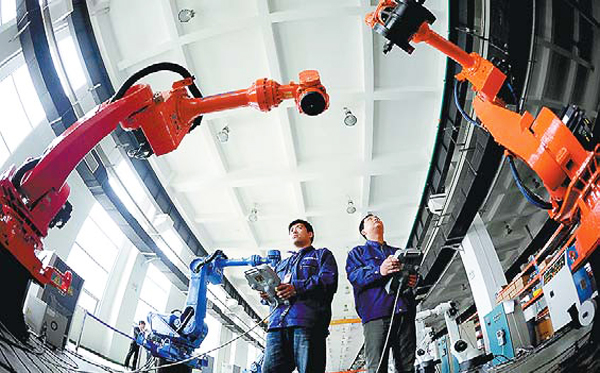Targeted reform can help revive northeast
 |
|
Workers test industrial robots at a Siasun Robot & Automation Co Ltd plant in Shenyang, Liaoning province. [Photo provided to China Daily] |
In his report to the 19th National Congress of the Communist Party of China, General Secretary Xi Jinping re-emphasized the urgency to deepen reform and revive the industrial base of Northeast China.
In fact, since the 16th Party Congress in 2002, revitalization of the northeastern region has been a significant strategic measure of the Chinese leadership to promote harmonious regional economic development. But even after more than a decade of efforts by governments at various levels and despite a series of supportive policies and special funds, the desired results have not been achieved.
Many scholars have come up with suggestions and plans to revitalize Northeast China. Economist Justin Yifu Lin's research group, for example, released a report, suggesting that Jilin province make use of its comparative advantages to regain its "glorious past".
Reform should be aimed at solving the economic problems and overcoming the development shortcomings. The problem is that the key economic weakness of Northeast China may not be related to a specific industry, as professor Lin's team said, but to the business environment in the region as a whole.
The key to revitalizing the region, therefore, lies in making it more attractive to investment, by improving its business environment. For investors, reviewing the local business environment is necessary before making any decision to invest in order to make sure their invested capital yields satisfactory returns.
Since the beginning of reform and opening-up, foreign investment has flowed into reform pilot regions with comparatively good business environments. And the continuous improvement in China's business environment ensured foreign investment in China increased with each passing year.
There's a direct relationship between a region's business environment and an increase in its investments. China's eastern and southern coastal regions attract more investments because of their good business environments. But investors are unwilling to cross Shanhaiguan in Hebei province and "risk" their money in the northeastern region, as a recent Chinese saying goes.
Entrepreneurs generally assume the business environment in Northeast China lags far behind that of the coastal regions, and hence they are reluctant to invest there.
In the first half of this year, the fixed-asset investment growth rates of Heilongjiang, Jilin and Liaoning provinces were 6.6 percent, 2.4 percent and minus 31.4 percent, respectively, all lower than the national average. Last year, the fixed-asset investment growth rates of Heilongjiang, Jilin and Liaoning were 5.5 percent, 10.1 percent and minus 63.5 percent, respectively, with only Jilin registering a slightly higher rate than the national average.
Fortunately, the governments of the three northeastern provinces are aware of the poor business environment and its impact on the region's economy. Liaoning has issued an ordinance to improve the province's business environment. And the three provincial governments are expected to make more efforts to improve their business environments, through deepened reform measures such as streamlining the administration and delegating power to the lower levels of governments, in order to attract more investments. The governments could also release a negative list, allowing potential investors to choose which industries they want to invest in.
Some surveys show enterprises in Northeast China are burdened by problems, lack vitality and have low profitability, because of the region's poor business environment.
So the region's governments have no choice but to improve their business environments if they want to make their enterprises more competitive and profitable. And an improvement in their business environments will also help reduce their enterprises' institutional costs and allow the entrepreneurs to pay more attention to business development.
An improved business environment will make the region more attractive to investors, too, and thus promote the virtuous circle of economic development and enterprises' profitability, which ultimately will help revitalize Northeast China.
The author is a researcher at Chinese Enterprise Confederation.









